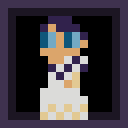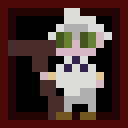Signeadown
Its motives, leadership, and structure are kept secret, even from most of the Signeadown's own members. It can communicate through any distance or medium, and it maintains a subtle hold on the affairs of the continent. It offers sporadic assistance to researchers, explorers, and militaries on all sides of Agrophon. Though its cryptic plans are usually aligned with Ornity's conquests, the Signeadown is on nobody's side but its own.
The signets claim to help the world by advancing the plans of Agrophon's deities. They do this through the makeshift field of "predictive theology," the use of research and reasoning to infer what the gods will do in the future. Divine projects and conflicts can take centuries, so their actions can be foretold many years in advance. After all, each god only has a few characteristic powers, which they tend to use whenever possible. Every divine choice, from natural disasters to holy wars to the shape of the continent itself, is motivated and predictable. The Signeadown has written thousands of pages, most of them secret, on stories and miracles which won't happen for a long time.
When asked for an example of its work, the Signeadown always points to the mysterious tidal wave which crushed a Kudoan hamlet in 613. Hundreds were killed because the wave struck with no divine or geological warning, but the Signeadown knew it was coming for months. The behemoth Pelages had good reason to go near the coast; he would pass within reach of his rival, the sea god Chelys; by calculating the paths of the two actors, the Signeadown predicted the tidal wave and guessed the exact year and month it would happen. But they gave no warning to the impacted civilians. They just watched.
For now, the Signeadown seems to be taking its time. They claim territory here and there, sometimes they purchase land from Ornity and Haust, and they build scattered shrines in odd locations. They claim to know about the next major catastrophe in Agrophon, and they insist it's coming soon, but they don't seem to be worried about it. If anything, they're setting the stage for it to happen.
Structure
The roles and communications of the Signeadown are kept secret through divine channels. Most signets who are seen in public are humble priests and enforcers who aren't told anything they don't need to know. They only know the tasks they're given, and their connection to the organization is mostly through faith.
Public Agenda
According to their recruiters, the Duumvirate War is a silly distraction, and a far more meaningful change is coming in Agrophon. No sacrifice is too great to facilitate that change. Agrophon's gods can see the bigger picture. How couldn't you trust them?
Assets
Their numbers aren't so impressive, but they have a disproportionate wealth of gold and magic. Some signets live in the most wild and inhospitable parts of the continent, but thriving environments sprout beneath them. Many of their shrines have been conquered over the years, but they don't seem to mind: they recover promptly from attacks while their attackers suffer in the long run. The Signeadown boasts that they have dozens of gods on their side, and people are finally starting to believe them.
Even low-ranking signets tend to have a glamorous appearance when representing their order. Their clothing is patterned with swan-downs, and even the plates of their armor are shaped like feathers. The gleaming white plumes are balanced by glassy amber highlights and jewelry black as pitch. When these people speak for the Signeadown, they want everyone to know it from a single glance.
Developments - Act I
Developments - Act II
Developments - Act III
Copper Coil Wands
These yew wands bound with loops of copper wire are produced by the Signeadown for long-distance communication. They allow two people, who have met in person and each own a wand, to send brief messages to each other. Groups of ten or more signets usually have one Copper Coil Wand between them, which they use to send word to other shrines and patrols. Some well-connected signets have four such wands in a magazine on their belt, allowing them to send and receive around 600 words each day.
Copper Coil Wand
Wand Uncommon
This wand has 7 charges. While holding it, you can expend 1 charge to cast the Sending spell. You can only send a message to creatures who have a Copper Coil Wand. The wand regains 1d4+1 expended charges daily at dawn. If you expend the wand's last charge, roll a d20. On a 1, the wand crumbles into ashes and is destroyed.
Cost: 70gp Weight: 0.5lb
Something feels off about the Signeadown agents. They're dismissive about dangerous situations, and while they're rarely coaxed into fights, they never seem to lose. It's slowly becoming clear that signets of all ranks are people of exceptional skill, even among the continent's small community of adventurers.
Atropasignets are sturdy diplomats. Dressed in simple robes and carrying no weapons, they maintain their organization's pristine image. Their jewelry resembles leaves and berries, the appealing image of nightshade.
Nelumbosignets are relentless peacemakers. Their robes and half plate armor stay perfectly clean, no matter how bloody things get. Their jewelry resembles lotus leaves, whose material famously deflects water through some mysterious chemical property.
Maihuenisignets are tenacious scouts. The land accommodates them to survive and blend in anywhere. Their jewelry resembles flowering cacti; supposedly it represents sturdiness, but every other jewel is oddly sharp to the touch.
Siliques
Once the Signeadown gained access to unparalleled magic, they took inspiration from the Cuspin Gourd and created devices which could conceal their numbers and power. A silique is a tall jade censer with a half-twist in the base, small and light enough to be concealed under robes, its lid decorated with jade leaves and pods. It's a tether to a miniature world created by the Imprisonment spell, the size of a large house, equipped with both luxuries and training rooms, and suppressing the need to eat or sleep. A code word, distinct to each censer, allows a creature to enter this little world; a second code word expels everyone out. An undercover signet may carry a silique with a dozen soldiers inside, waiting or relaxing in reserve. If the silique carrier gives them sufficient warning, these soldiers can be ready to spring out at a moment's notice.Rafflesiasignets
If Monarch himself makes an appearance at one of his shrines, he might donate his magic to those who want to help him but don't have the strength. These people become incredibly powerful servants, and are usually turned loose to seek out Monarch's enemies and fulfill their worst impulses. Monarch can only sustain so many Rafflesiasignets at once, so he'll sometimes take away their powers without warning and give them to someone else.Mythology & Lore
They teach a few short myths about every god in Agrophon to explain their qualities and actions. Botryte is a fanatical necromancer who can twist the cycle of life, and once tormented a farmer with endless blights because she proved to be a better singer. E-cer was a temperamental artist who could sculpt the landmass of Agrophon, and once built the sea as a place to vacation away from needy mortals. Chelys is a stalwart matron who guides the mischievous waters, and once flooded a city to protect it from a land invasion, educating its people in the virtue of sacrifice.
These godly tales, because of their sensationalist prose and simplified portrayals of their characters, drew many new subjects to the Signeadown. The new signets told these stories over and over, crafting their idealized versions of Agrophon's deities, and using them in their predictions. Some theologians believe the Signeadown raised its own little pantheon, created from its misguided ideas of what the gods are thinking. For instance, Languisse would never tie a man to a standing stone for days just to teach him a lesson, but Signet-Languisse might.
Divine Origins
For a religion which claims to serve the will of the whole continent, the Signeadown is a very young organization. About a century ago, the founder of predictive theology (whose name is undisclosed) formed the religion in order to study the gods' strategies and probable course of action. The Signeadown was created for pragmatic reasons: its members want to stay on the winning side of every conflict, to establish clear morals in a conflicted world, and to find relief from the uncertainty of daily life. They always know what's happening in Agrophon; or, at least, their superiors surely know.
Tenets of Faith
Despite its intense practices, the Signeadown's laws are malleable and open to debate. Its stories about the future are the subjects of lively arguments, as predictors develop conflicting theories on how the gods will proceed. They welcome controversial opinions, as long as they're truly intended to benefit the Signeadown's intel and position. But for all their open-mindedness, there are some things they just can't allow.
To the signets, impeding the gods' work is counterproductive and will only cause misery. If a deity is trying to work, and other deities won't intervene, why would a mortal be able to intervene in a positive way? The best way to overcome misery is not to challenge the gods, but to help them work as efficiently as possible, until it all ends, one way or another. Mortals who challenge deities are considered enemies of the Signeadown, and are swept off the continent whenever possible.
Signets are expected to learn as much as they can about the gods, and as little as they can about the Signeadown, to preserve the security of their organization. They avoid all knowledge of their superiors and colleagues, and trust that they'll receive only the information they need. However, the few signets who know each other have frequent informal meetings to discuss their work, and develop their opinions on who is worthy to live in Agrophon.
The Signeadown is especially hateful of falsified creatures. It sees them as an unfortunate side-effect of Oscuridell's hasty work, flawed bodies whose tortured minds deserve better. Signets are driven to kill these creatures on sight, before they can muddy the elegant designs of Agrophon. Some people even agree that their goal is noble and merciful.
But fell creatures aren't their only targets. The Signeadown expresses hatred for a variety of people, and every signet has different tastes.
Founding Date
602
Type
Religious, Holy Order
Alternative Names
The Swan Song
Demonym
Signet
Notable Members
Remove these ads. Join the Worldbuilders Guild









Comments